Effects of Varying Rates of Nitrogen and Biochar pH on NH3 Emissions and Agronomic Performance of Chinese Cabbage (Brassica rapa ssp. pekinensis)
Abstract
:1. Introduction
2. Materials and Methods
2.1. Experimental Setup
2.2. Ammonia Volatilization Field Experiment
2.3. Preparation of Biochar, and Laboratory Analysis of the Soil, Biochar and Plant Tissue
2.4. Statistical Analysis
3. Results and Discussion
3.1. Ammonia Volatilization
3.2. Chinese Cabbage Yield and Soil Chemical Properties
4. Conclusions
Author Contributions
Funding
Institutional Review Board Statement
Informed Consent Statement
Data Availability Statement
Conflicts of Interest
References
- Luyima, D.; Egyir, M.; Lee, J.-H.; Yoo, J.-H.; Oh, T.-K. A review of the potentiality of biochar technology to abate emissions of particulate matter originating from agriculture. Int. J. Environ. Sci. Technol. 2021. [Google Scholar] [CrossRef]
- Atkinson, R.W.; Mills, I.C.; Walton, H.A.; Anderson, H.R. Fine particle components and health—A systematic review and meta-analysis of epidemiological time series studies of daily mortality and hospital admissions. J. Expo. Sci. Environ. Epidemiol. 2015, 25, 208–214. [Google Scholar] [CrossRef] [Green Version]
- Anderson, J.O.; Thundiyil, J.G.; Stolbach, A. Clearing the Air: A Review of the Effects of Particulate Matter Air Pollution on Human Health. J. Med. Toxicol. 2012, 8, 166–175. [Google Scholar] [CrossRef] [PubMed] [Green Version]
- Luyima, D.; Egyir, M.; Yun, Y.-U.; Park, S.-J.; Oh, T.-K. Nutrient Dynamics in Sandy Soil and Leaf Lettuce Following the Application of Urea and Urea-Hydrogen Peroxide Impregnated Co-Pyrolyzed Animal Manure and Bone Meal. Agronomy 2021, 11, 1664. [Google Scholar] [CrossRef]
- Ma, R.; Zou, J.; Han, Z.; Yu, K.; Wu, S.; Li, Z.; Liu, S.; Niu, S.; Horwath, W.R.; Zhu-Barker, X. Global soil-derived ammonia emissions from agricultural nitrogen fertilizer application: A refinement based on regional and crop-specific emission factors. Glob. Chang. Biol. 2020, 27, 855–867. [Google Scholar] [CrossRef]
- Sohi, S.P.; Krull, E.; Lopez-Capel, E.; Bol, R. A review of biochar and its use and function in soil. In Advances in Agronomy; Academic Press: Cambridge, MA, USA, 2010; Volume 105, pp. 47–82. [Google Scholar] [CrossRef]
- Oh, T.-K.; Lee, J.-H.; Kim, S.-H.; Lee, H.-C. Effect of biochar application on growth of Chinese cabbage (Brassica chinensis). Korean J. Agric. Sci. 2017, 44, 359–365. [Google Scholar] [CrossRef]
- Tomczyk, A.; Sokołowska, Z.; Boguta, P. Biochar physicochemical properties: Pyrolysis temperature and feedstock kind effects. Rev. Environ. Sci. Biotechnol. 2020, 19, 191–215. [Google Scholar] [CrossRef] [Green Version]
- Luyima, D.; Lee, J.H.; Sung, J.; Oh, T.K. Co-pyrolysed animal manure and bone meal-based urea hydrogen peroxide (UHP) fertilisers are an effective technique of combating ammonia emissions. J. Mater. Cycles Waste Manag. 2020, 22, 1887–1898. [Google Scholar] [CrossRef]
- Luyima, D.; Sung, J.; Lee, J.-H.; Woo, S.-A.; Park, S.-J.; Oh, T.-K. Sorption of urea hydrogen peroxide by co-pyrolysed bone meal and cow dung slowed-down phosphorus and nitrogen releases but boosted agronomic efficiency. Appl. Biol. Chem. 2020, 63, 52. [Google Scholar] [CrossRef]
- Yang, C.; Liu, J.; Lu, S. Pyrolysis temperature affects pore characteristics of rice straw and canola stalk biochars and biochar-amended soils. J. Geoderma 2021, 397, 115097. [Google Scholar] [CrossRef]
- Edeh, I.G.; Masek, O.; Buss, W. A meta-analysis on biochar’s effects on soil water properties—New insights and future research challenges. Sci. Total Environ. 2020, 714, 136857. [Google Scholar] [CrossRef] [PubMed]
- Mandal, S.; Thangarajan, R.; Bolan, N.S.; Sarkar, B.; Khan, N.; Ok, Y.S.; Naidu, R. Biochar-induced concomitant decrease in ammonia volatilization and increase in nitrogen use efficiency by wheat. Chemosphere 2015, 142, 120–127. [Google Scholar] [CrossRef]
- Maurer, D.L.; Koziel, J.A.; Kalus, K.; Andersen, D.S.; Opalinski, S. Pilot-Scale Testing of Non-Activated Biochar for Swine Manure Treatment and Mitigation of Ammonia, Hydrogen Sulfide, Odorous Volatile Organic Compounds (VOCs), and Greenhouse Gas Emissions. Sustainability 2017, 9, 929. [Google Scholar] [CrossRef] [Green Version]
- Searle, P.L. The Berthelot or indophenol reaction and its use in the analytical chemistry of nitrogen. A review. Analyst 1984, 109, 549–568. [Google Scholar] [CrossRef]
- Singh, B.; Dolk, M.M.; Shen, Q.; Camps-Arbestain, M. Chapter 3: Biochar pH, electrical conductivity and liming potential. In Biochar: A Guide to Analytical Methods, 1st ed.; Singh, B., Camps-Arbestain, M., Lehmann, J., Eds.; CRC Press: New York, NY, USA, 2017; pp. 23–38. [Google Scholar] [CrossRef]
- Murphy, J.; Riley, J.P. A modified single solution method for the determination of phosphate in natural waters. Anal. Chim. Acta 1962, 27, 31–36. [Google Scholar] [CrossRef]
- Enders, A.; Sohi, S.; Lehmann, J.; Singh, B. Chapter 9: Total elemental analysis of metals and nutrients in biochars. In Biochar: A Guide to Analytical Methods, 1st ed.; Singh, B., Camps-Arbestain, M., Lehmann, J., Eds.; CRC Press: New York, NY, USA, 2017; pp. 95–108. [Google Scholar]
- Degaspari, I.A.; Soares, J.R.; Montezano, Z.F.; Del Grosso, S.J.; Vitti, A.C.; Rossetto, R.; Cantarella, H. Nitrogen sources and application rates affect emissions of N2O and NH3 in sugarcane. Nutr. Cycl. Agroecosyst. 2020, 116, 329–344. [Google Scholar] [CrossRef]
- Fan, R.; Chen, C.-L.; Lin, J.-Y.; Tzeng, J.-H.; Huang, C.-P.; Dong, C.; Huang, C.P. Adsorption characteristics of ammonium ion onto hydrous biochars in dilute aqueous solutions. Bioresour. Technol. 2018, 272, 465–472. [Google Scholar] [CrossRef]
- Sommer, S.G.; Olesen, J.E.; Christensen, B.T. Effects of temperature, wind speed and air humidity on ammonia volatilization from surface applied cattle slurry. J. Agric. Sci. 1991, 117, 91–100. [Google Scholar] [CrossRef]
- Lee, J.H.; Luyima, D.; Lee, J.Y.; Kim, S.J.; Son, M.K.; Yoon, C.W.; Choi, Y.J.; Choi, H.Y.; Shinogi, Y.; Park, K.W.; et al. Effects of Two Biochar–based Organic Amendments on Soil Chemical Properties and Productivity of Selected Vegetables. J. Fac. Agric. Kyushu Univ. 2019, 64, 39–46. [Google Scholar] [CrossRef]
- Luyima, D.; Lee, J.H.; Yoo, J.H.; Kim, S.H.; Shinogi, Y.; Sung, J.K.; Oh, T.K. Post-pyrolysis nutrient enhancement of wood biochar with compost and uncharred wastes- influence on soil chemical properties and crop productivity. J. Fac. Agric. Kyushu Univ. 2019, 64, 199–204. [Google Scholar] [CrossRef]
- Luyima, D.; Lee, J.-L.; An, J.-Y.; Kwon, O.-S.; Park, S.-Y.; Lee, S.-J.; Park, S.-Y.; Shinogi, Y.; Park, K.-W.; Oh, T.-K. Impact of Synchronizing the Application of Different Biochar Organic Fertilisers with NPK on Soil Chemical Properties and Growth of Leek (Allium ampeloprasum). J. Fac. Agric. Kyushu Univ. 2019, 64, 47–53. [Google Scholar] [CrossRef]
- Yoo, J.-H.; Luyima, D.; Lee, J.-H.; Park, S.-Y.; Yang, J.-W.; An, J.-Y.; Yun, Y.-U.; Oh, T.-K. Effects of brewer’s spent grain biochar onthe growth and quality of leaf lettuce (Lactuca sativa L. var. crispa.). Appl. Biol. Chem. 2021, 64, 10. [Google Scholar] [CrossRef]
- Nigussie, A.; Kissi, E.; Misganaw, M.; Ambaw, G. Effect of bio-char application on soil properties and nutrient uptake of lettuces (Lactuca sativa) grown in chromium polluted soils. Am. Eurasian J. Agric. Environ. Sci. 2012, 12, 369–376. [Google Scholar]
- Arocena, J.M.; Opio, C. Prescribed Fire Induced Changes in Properties of Sub Boreal Forest Soils. Geoderma 2003, 113, 1–16. [Google Scholar] [CrossRef]
- Khanna, P.K.; Raison, R.J.; Falkiner, R.A. Chemical properties of ash derived from Eucalyptus litter and its effects on forest soils. For. Ecol. Manag. 1994, 66, 107–125. [Google Scholar] [CrossRef]
- Chintala, R.; Mollinedo, J.; Schumacher, T.E.; Malo, D.D.; Julson, J.L. Effect of biochar on chemical properties of acidic soil. Arch. Agron. Soil Sci. 2013, 60, 393–404. [Google Scholar] [CrossRef]
- Hailegnaw, N.S.; Mercl, F.; Pračke, K.; Száková, J.; Tlustoš, P. Mutual relationships of biochar and soil pH, CEC, and exchangeable base cations in a model laboratory experiment. J. Soils Sediments 2019, 19, 2405–2416. [Google Scholar] [CrossRef]
- Vavrina, C.S.; Obreza, T.A. Response of Chinese cabbage to Nitrogen Rate and Source in Sequential Plantings. HortScience 1993, 28, 1164–1165. [Google Scholar] [CrossRef] [Green Version]
- Yeshiwas, Y. Effect of different rate of nitrogen fertilizer on the growth and yield of cabbage (Brassica oleraceae) at Debre Markos, North West Ethiopia. Afr. J. Plant Sci. 2017, 11, 276–281. [Google Scholar] [CrossRef] [Green Version]
- Baiga, R.; Rajashekhar Rao, B.K. Effects of biochar, urea and their co-application on nitrogen mineralization in soil and growth of Chinese cabbage. Soil Use Manag. 2017, 33, 54–61. [Google Scholar] [CrossRef] [Green Version]
- Qi, F.; Dong, Z.; Naidu, R.; Bolan, N.S.; Lamb, D.; Ok, Y.-S.; Liu, C.; Khan, N.; Johir, M.A.H.; Semple, K.T. Effects of acidic and neutral biochars on properties and cadmium retention of soils. Chemosphere 2017, 180, 564–573. [Google Scholar] [CrossRef] [PubMed] [Green Version]
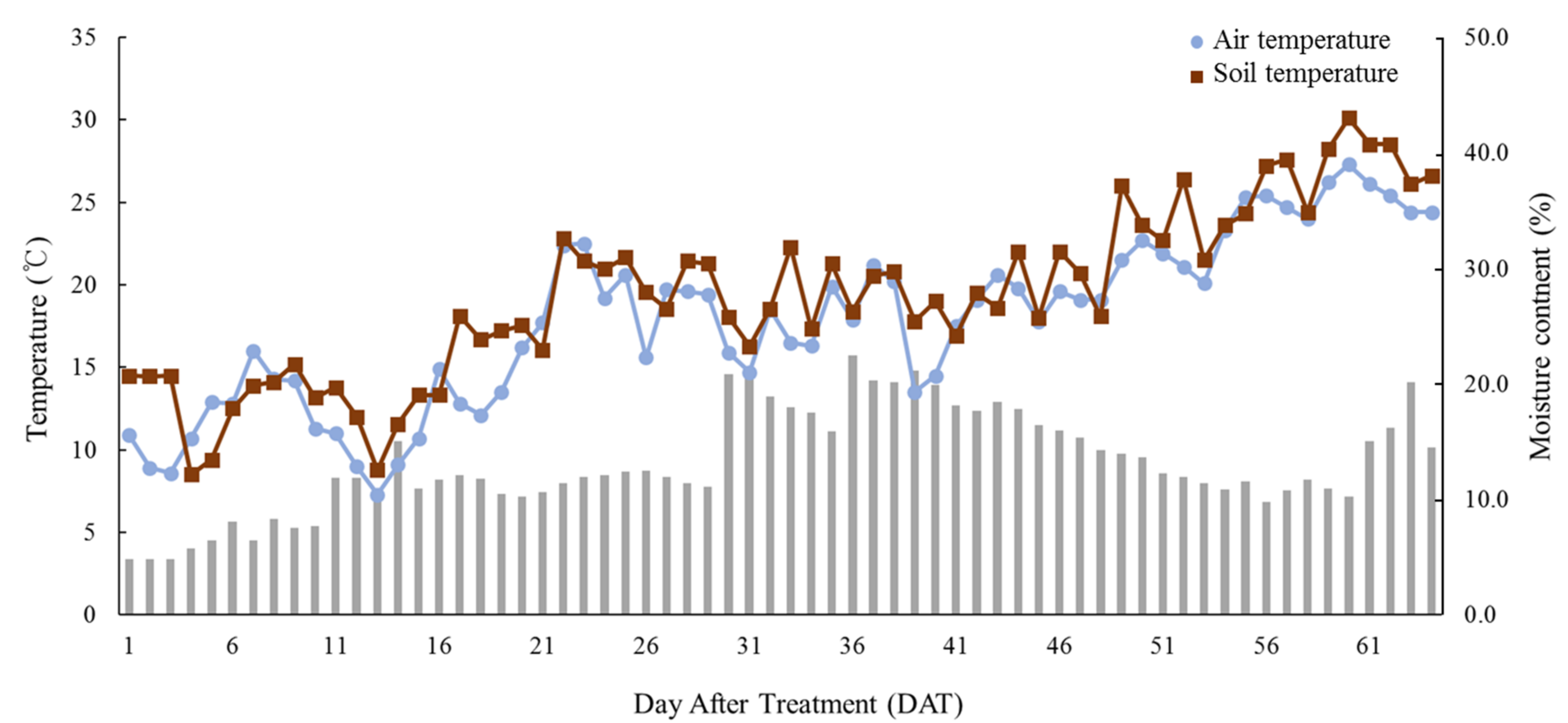
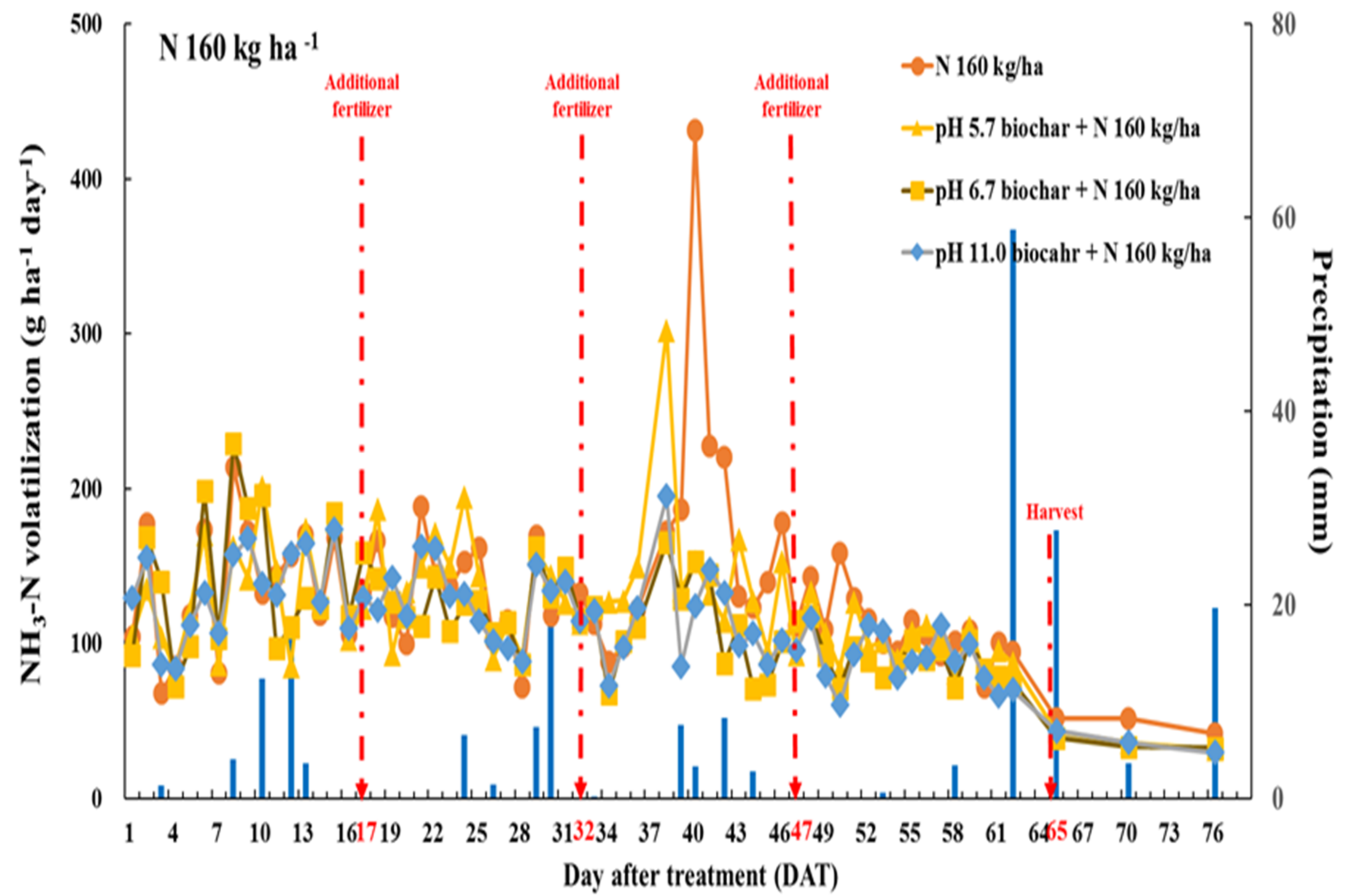
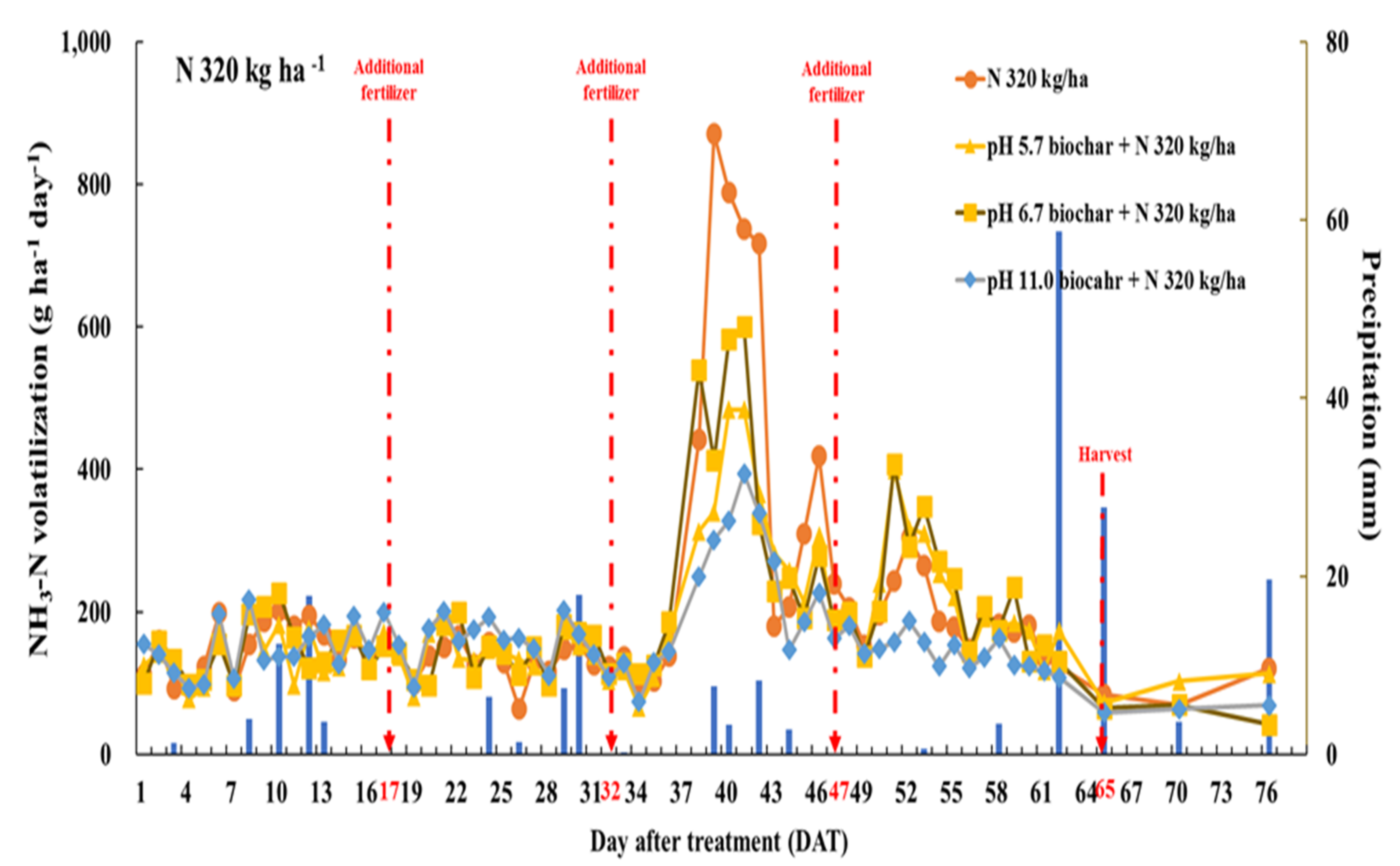
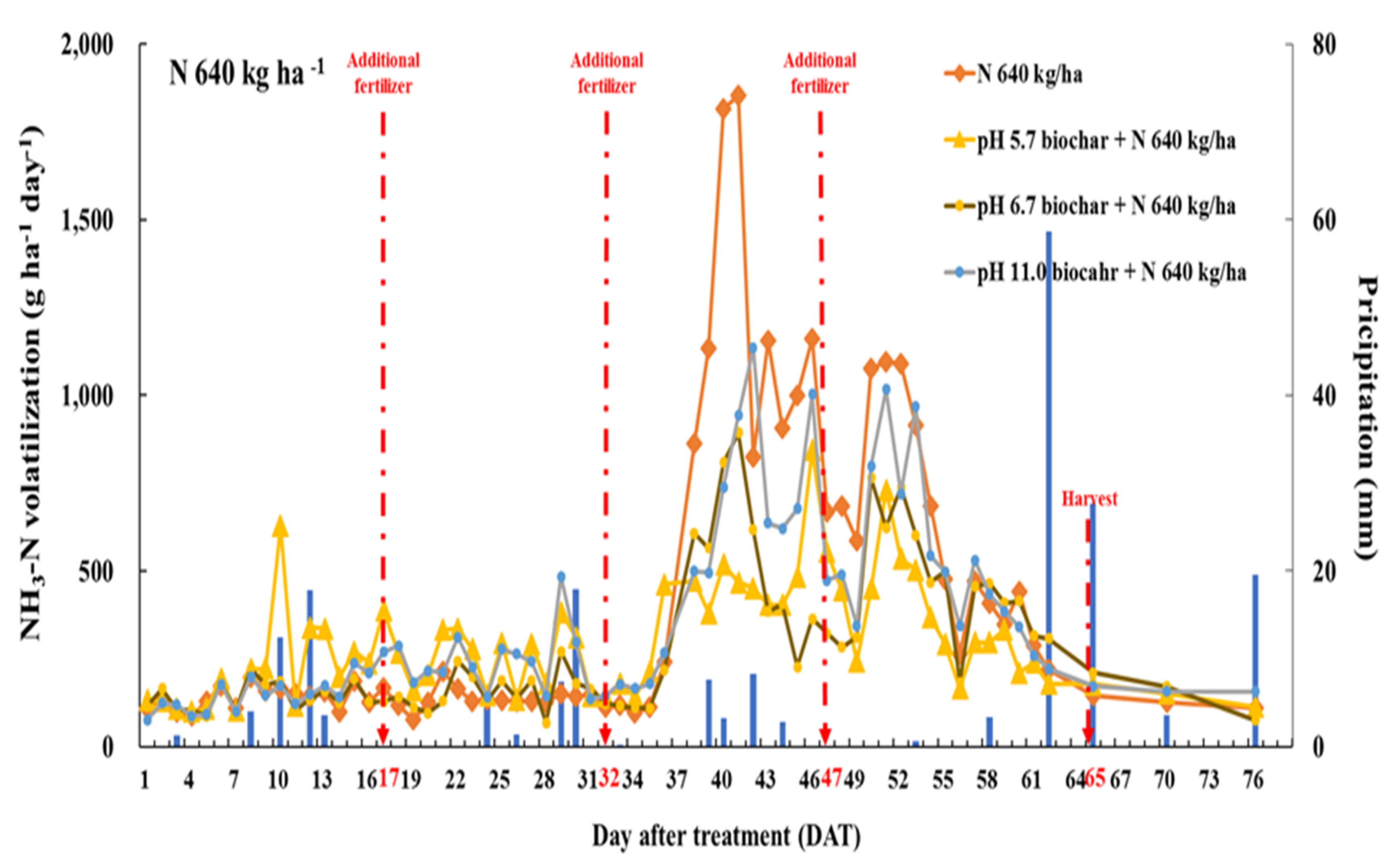
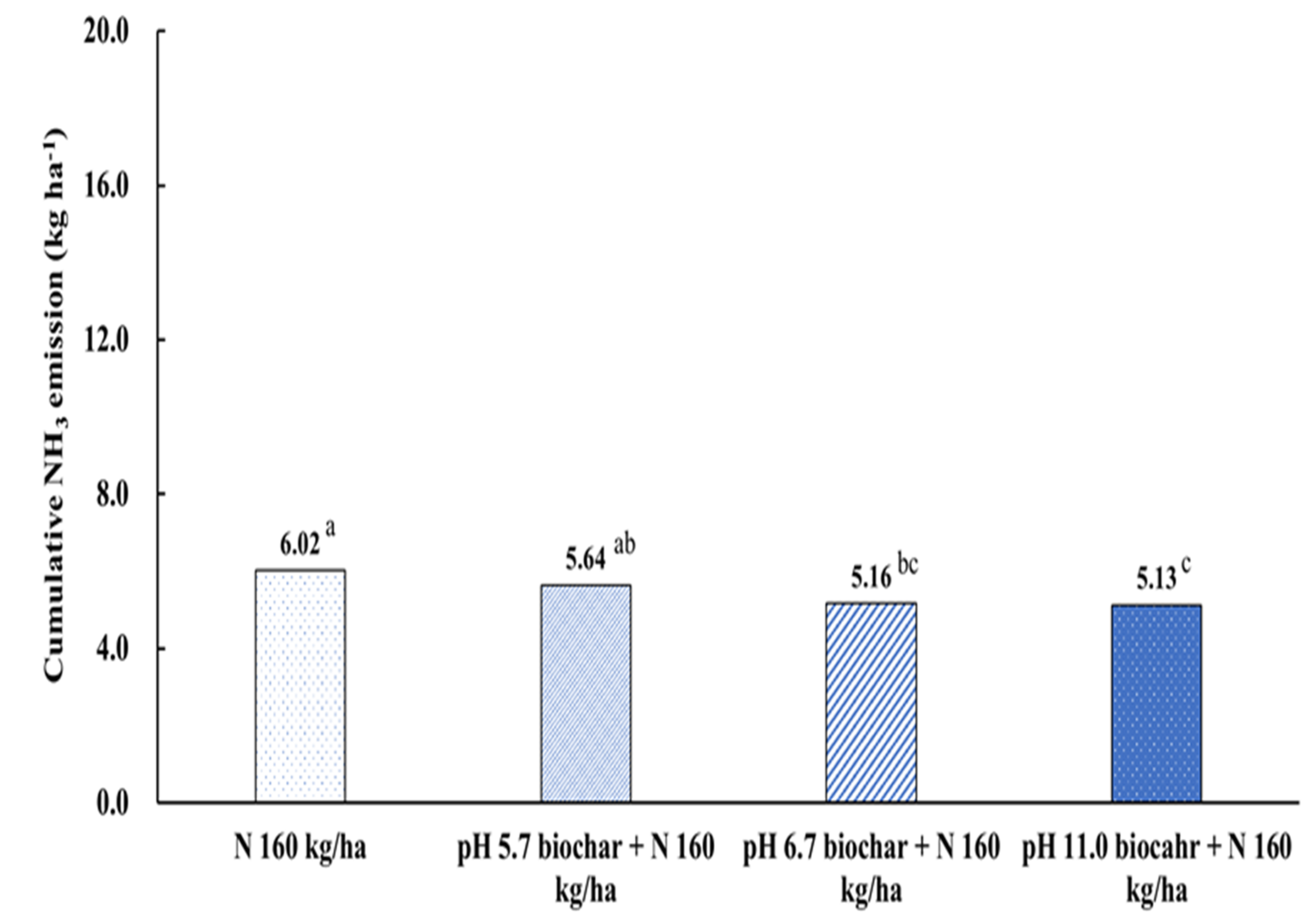
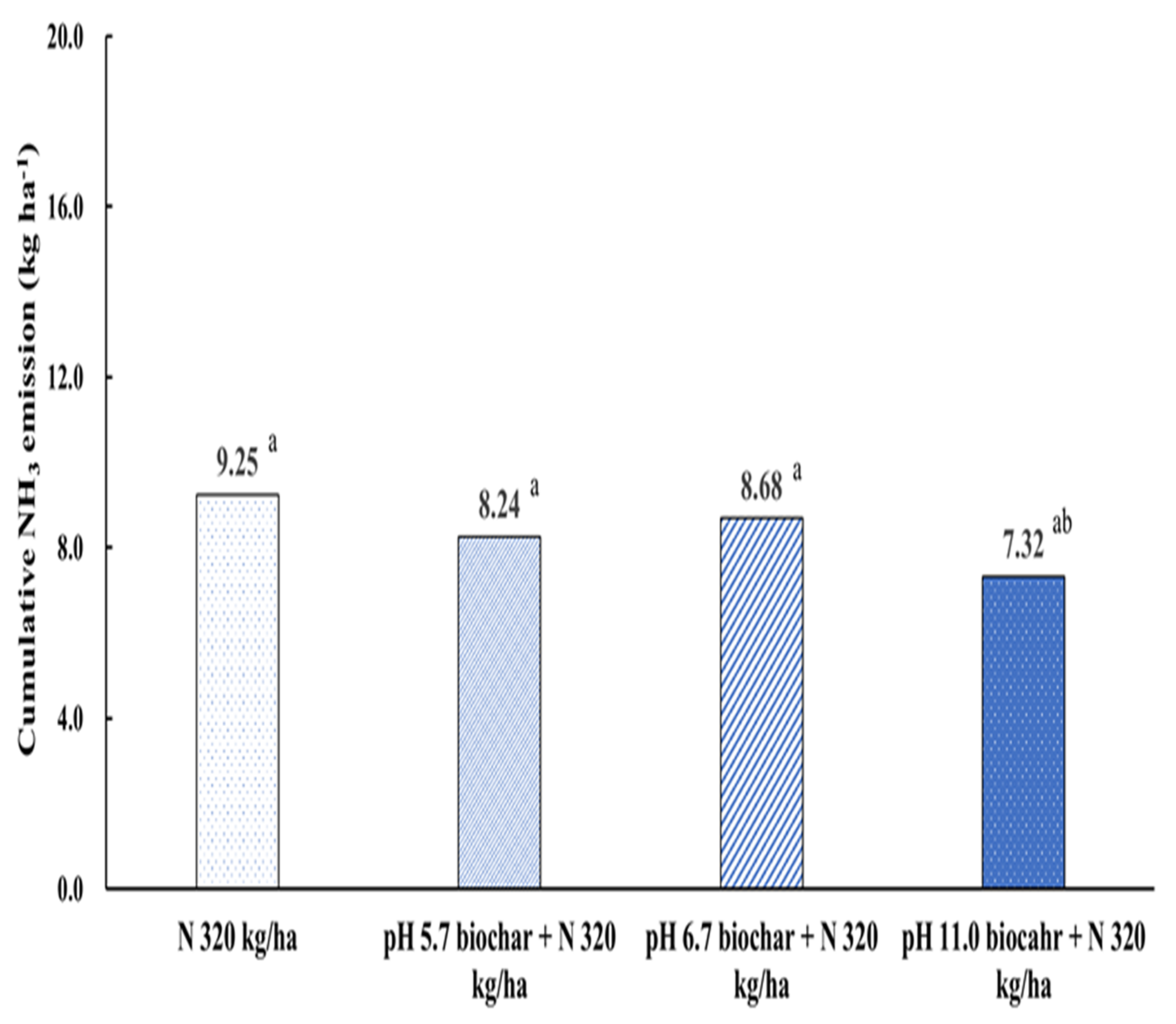
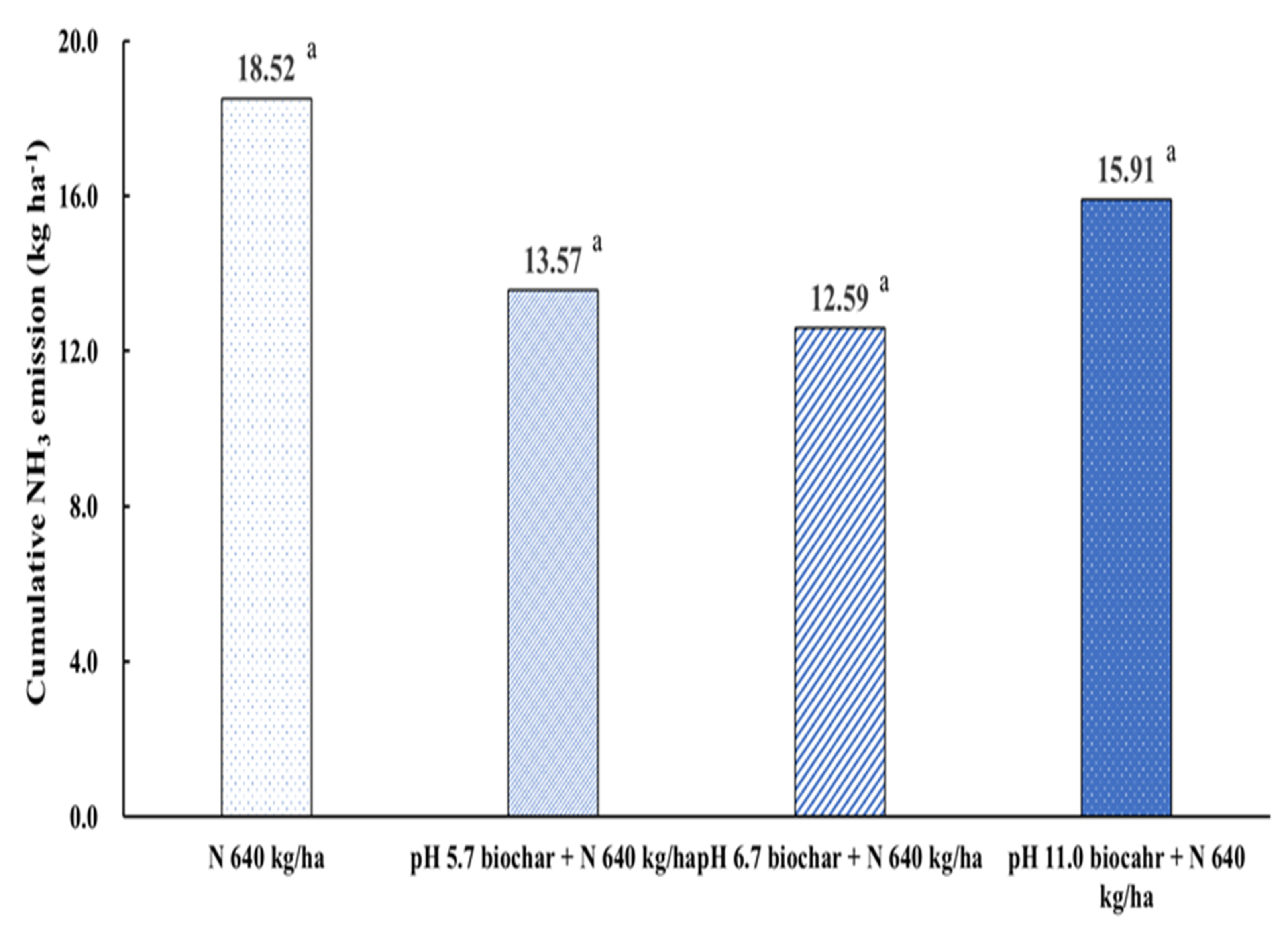
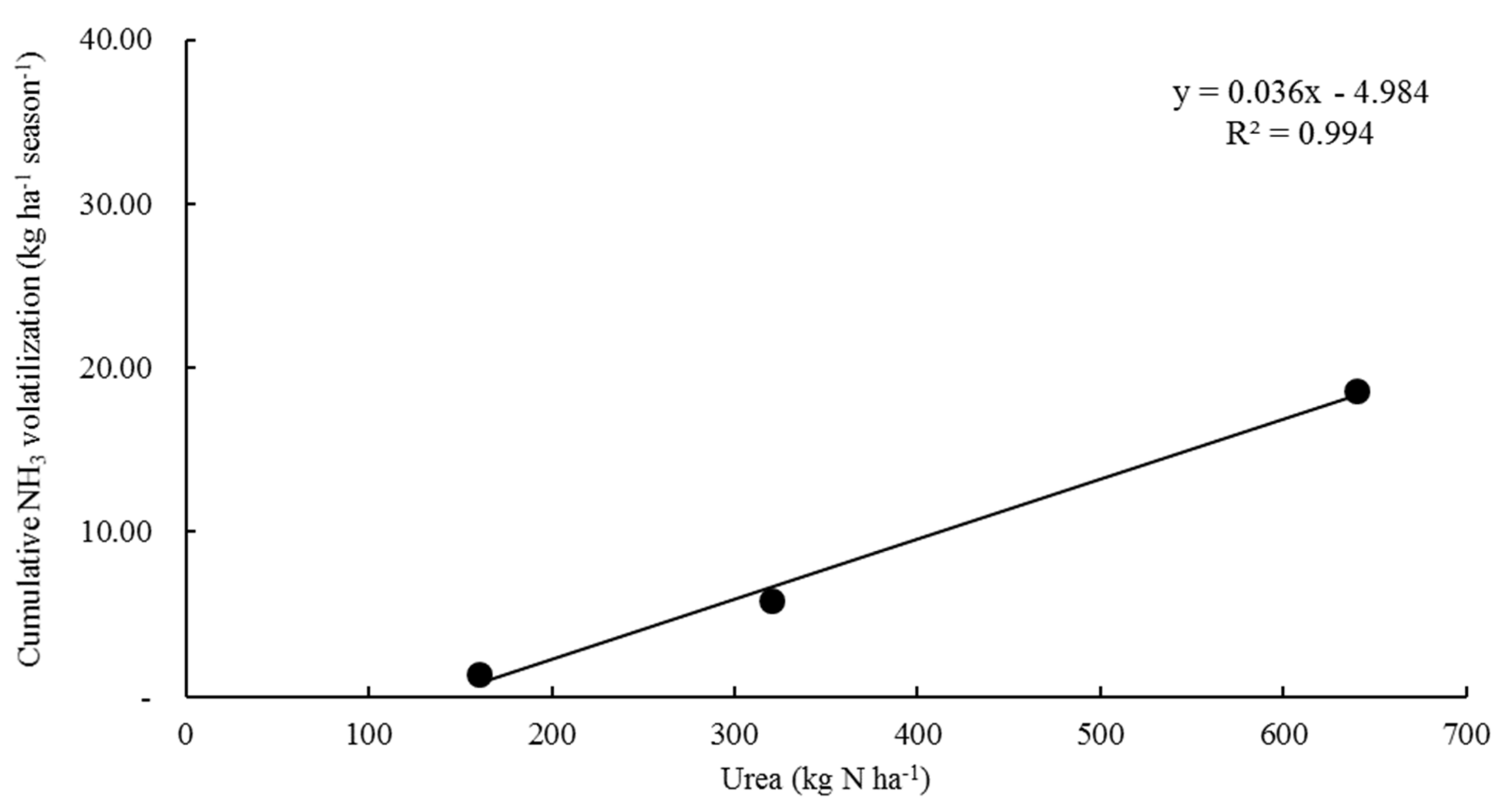
| pH | EC | T-C | T-N | Av. P2O5 | Ca2+ | K+ | Mg2+ | Na+ |
|---|---|---|---|---|---|---|---|---|
| (1:5, H2O) | (dS m−1) | (%) | (mg kg−1) | (cmolc kg−1) | ||||
| 5.8 ± 0.2 | 0.34 ± 0.01 | 0.62 ± 0.01 | 0.14 ± 0.01 | 34.65 ± 35.48 | 3.20 ± 0.05 | 0.40 ± 0.02 | 1.94 ± 0.01 | 0.08 ± 0.01 |
| Pyrolysis Temp. | pH | EC | T-C | T-N | T-P | Ca | K | Mg | Na |
|---|---|---|---|---|---|---|---|---|---|
| (°C) | (1:10) | (dS m−1) | (%) | ||||||
| 350 | 5.7 ± 0.14 | 3.40 ± 0.24 | 41.3 ± 4.87 | 0.38 ± 0.04 | 0.14 ± 0.03 | 0.14 ± 0.03 | 0.34 ± 0.01 | 0.04 ± 0.00 | 0.02 ± 0.00 |
| 450 | 6.7 ± 0.21 | 1.33 ± 0.11 | 44.1 ± 4.20 | 0.36 ± 0.07 | 0.06 ± 0.01 | 0.15 ± 0.02 | 0.48 ± 0.09 | 0.05 ± 0.01 | 0.01 ± 0.00 |
| 600 | 11.0 ± 0.18 | 1.83 ± 0.15 | 54.9 ± 6.23 | 0.58 ± 0.09 | 0.21 ± 0.05 | 0.33 ± 0.01 | 0.81 ± 0.04 | 0.12 ± 0.04 | 0.05 ± 0.02 |
| Treatment | pH | EC | T-C | T-N | Avail. P | Ca2+ | K+ | Mg2+ | Na+ | |
|---|---|---|---|---|---|---|---|---|---|---|
| (1:5, H2O) | (dS m−1) | (%) | (mg kg−1) | (cmolc kg−1) | ||||||
| N 160 kg ha−1 | Only urea | 6.5 ± 0.4 a | 0.94 ± 0.47 ab | 0.56 ± 0.13 c | 0.20 ± 0.10 a | 122.27 ± 50.14 a | 2.48 ± 0.12 a | 0.95 ± 0.40 a | 1.65 ± 0.39 a | 0.16 ± 0.08 a |
| pH 5.7 biochar | 6.7 ± 0.1 a | 0.67 ± 0.15 b | 1.24 ± 0.23 a | 0.23 ± 0.08 a | 74.61 ± 2.56 d | 2.35 ± 0.22 a | 0.69 ± 0.36 a | 1.50 ± 0.21 a | 0.11 ± 0.03 a | |
| pH 6.7 biochar | 6.5 ± 0.4 a | 0.81 ± 0.11 b | 1.14 ± 0.56 ab | 0.20 ± 0.06 a | 90.80 ± 31.61 c | 2.46 ± 0.10 a | 0.70 ± 0.07 a | 1.71 ± 0.08 a | 0.14 ± 0.03 a | |
| pH 11.0 biochar | 6.7 ± 0.2 a | 1.32 ± 0.08 a | 1.74 ± 0.03 a | 0.21 ± 0.04 a | 105.14 ± 38.23 b | 2.57 ± 0.36 a | 0.99 ± 0.17 a | 1.78 ± 0.41 a | 0.16 ± 0.01 a | |
| N 320 kg ha−1 | Only urea | 6.4 ± 0.1 a | 0.81 ± 0.32 ab | 0.55 ± 0.09 c | 0.19 ± 0.04 a | 114.57 ± 63.92 c | 2.72 ± 0.38 a | 0.58 ± 0.14 a | 1.69 ± 0.09 a | 0.12 ± 0.02 a |
| pH 5.7 biochar | 6.4 ± 0.4 a | 1.08 ± 0.22 b | 0.72 ± 0.21 b | 0.18 ± 0.11 a | 121.07 ± 50.44 b | 2.45 ± 0.08 a | 0.62 ± 0.05 a | 1.73 ± 0.24 a | 0.11 ± 0.01 a | |
| pH 6.7 biochar | 6.3 ± 0.2 a | 0.72 ± 0.18 b | 0.97 ± 0.12 ab | 0.24 ± 0.06 a | 63.72 ± 33.20 d | 2.57 ± 0.21 a | 0.63 ± 0.36 a | 1.64 ± 0.02 a | 0.22 ± 0.16 a | |
| pH 11.0 biochar | 6.6 ± 0.4 a | 0.82 ± 0.30 a | 2.02 ± 0.14 a | 0.19 ± 0.06 a | 134.88 ± 45.47 a | 2.38 ± 0.15 a | 0.89 ± 0.30 a | 1.66 ± 0.07 a | 0.20 ± 0.13 a | |
| N 640 kg ha−1 | Only urea | 6.3 ± 0.2 a | 1.38 ± 0.13 a | 0.51 ± 0.11 c | 0.18 ± 0.05 b | 80.18 ± 14.54 b | 2.44 ± 0.08 a | 0.61 ± 0.08 a | 1.67 ± 0.10 a | 0.12 ± 0.02 a |
| pH 5.7 biochar | 6.4 ± 0.4 a | 0.93 ± 0.03 a | 0.77 ± 0.18 b | 0.22 ± 0.06 b | 61.73 ± 49.65 c | 2.50 ± 0.24 a | 0.61 ± 0.22 a | 1.75 ± 0.26 a | 0.14 ± 0.06 a | |
| pH 6.7 biochar | 6.4 ± 0.1 a | 1.01 ± 0.49 a | 1.19 ± 0.31 ab | 0.19 ± 0.05 b | 81.78 ± 33.33 b | 2.37 ± 0.13 a | 0.52 ± 0.20 a | 1.58 ± 0.33 a | 0.10 ± 0.02 a | |
| pH 11.0 biochar | 6.5 ± 0.3 a | 1.36 ± 0.42 a | 2.01 ± 0.51 a | 0.42 ± 0.25 a | 127.44 ± 23.99 a | 2.51 ± 0.19 a | 0.64 ± 0.24 a | 1.65 ± 0.26 a | 0.11 ± 0.00 a | |
| Treatment | Head | Leaf | Chlorophyll | ||||||
|---|---|---|---|---|---|---|---|---|---|
| Fresh Weight | Dry Weight | Water Content | Height | Width | Length | Width | |||
| (g) | (%) | (mm) | (mm) | (SPAD) | |||||
| Control | 1364.0 ± 331.0 g | 116.0 ± 20.9 f | 90.4 ± 2.2 a | 204.8 ± 20.9 b | 120.9 ± 48.2 b | 264.1 ± 54.9 b | 191.1 ± 54.1 b | 75.4 ± 14.4 a | |
| N 160 kg ha−1 | Only urea | 2096.54 ± 257.5 ef | 148.6 ± 23.1 e | 92.8 ± 0.7 a | 254.7 ± 18.7 ab | 151.8 ± 14.1 ab | 317.1 ± 5.1 a | 212.1 ± 9.6 ab | 90.4 ± 10.5 a |
| pH 5.7 biochar | 1716.8 ± 201.8 fg | 141.8 ± 14.2 e | 92.0 ± 1.5 a | 239.6 ± 63.6 ab | 135.9 ± 22.8 ab | 292.3 ± 9.3 ab | 196.7 ± 17.6 b | 79.5 ± 18.6 a | |
| pH 6.7 biochar | 2118.0 ± 11.5 ef | 171.8 ± 0.4 c | 91.6 ± 0.7 a | 256.3 ± 6.3 ab | 147.9 ± 21.7 ab | 299.6 ± 16.5 ab | 209.3 ± 22.7 ab | 85.2 ± 17.9 a | |
| pH 11.0 biochar | 1581.3 ± 242.8 g | 131.9 ± 14.4 e | 91.0 ± 0.8 a | 237.5 ± 37.3 ab | 131.5 ± 32.6 ab | 298.2 ± 27.0 ab | 202.4 ± 33.3 b | 74.9 ± 15.8 a | |
| N 320 kg ha−1 | Only urea | 2533.7 ± 752.3 cde | 179.4 ± 51.4 bc | 92.8 ± 0.1 a | 255.9 ± 65.1 ab | 162.3 ± 11.2 ab | 320.9 ± 4.4 a | 223.8 ± 19.9 ab | 80.7 ± 19.8 a |
| pH 5.7 biochar | 2303.5 ± 156.0 de | 168.0 ± 3.0 c | 92.3 ± 0.7 a | 253.9 ± 15.1 ab | 146.8 ± 17.1 ab | 307.8 ± 10.4 a | 222.4 ± 30.6 abb | 80.8 ± 14.9 a | |
| pH 6.7 biochar | 2782.5 ± 23.5 cd | 174.3 ± 24.0 c | 92.9 ± 1.3 a | 239.9 ± 17.4 ab | 172.3 ± 29.0 ab | 332.9 ± 8.6 a | 255.0 ± 9.2 a | 82.9 ± 18.4 a | |
| pH 11.0 biochar | 2166.3 ± 86.8 ef | 152.6 ± 5.3 d | 92.3 ± 1.0 a | 272.1 ± 54.1 ab | 161.5 ± 9.8 ab | 334.8 ± 19.7 a | 224.1 ± 19.7 ab | 84.7 ± 7.3 a | |
| N 640 kg ha−1 | Only urea | 3307.5 ± 312.0 ab | 219.8 ± 34.5 ab | 93.0 ± 0.61 a | 271.7 ± 56.6 ab | 179.6 ± 8.3 a | 315.3 ± 20.3 a | 225.5 ± 25.4 ab | 85.2 ± 13.2 a |
| pH 5.7 biochar | 2505.8 ± 25.3 cde | 169.8 ± 10.7 c | 92.1 ± 1.57 ab | 234.7 ± 3.2 abb | 169.2 ± 43.4 ab | 317.6 ± 12.3 a | 227.1 ± 10.1 ab | 82.2 ± 15.0 a | |
| pH 6.7 biochar | 3521.0 ± 294.0 a | 242.1 ± 0.9 a | 92.2 ± 0.73 a | 280.5 ± 22.0 a | 183.9 ± 41.9 a | 307.1 ± 21.8 a | 218.6 ± 38.8 b | 80.7 ± 11.7 a | |
| pH 11.0 biochar | 2992.7 ± 215.9 b c | 196.0 ± 4.4 b | 93.4 ± 0.43 a | 264.6 ± 23.9 ab | 169.2 ± 11.2 ab | 323.3 ± 20.0 a | 226.6 ± 19.6 ab | 84.2 ± 18.3 a | |
Publisher’s Note: MDPI stays neutral with regard to jurisdictional claims in published maps and institutional affiliations. |
© 2021 by the authors. Licensee MDPI, Basel, Switzerland. This article is an open access article distributed under the terms and conditions of the Creative Commons Attribution (CC BY) license (https://creativecommons.org/licenses/by/4.0/).
Share and Cite
Kang, Y.-G.; Chun, J.-H.; Lee, J.-H.; Park, S.-Y.; Luyima, D.; Oh, T.-K.; Yun, Y.-U. Effects of Varying Rates of Nitrogen and Biochar pH on NH3 Emissions and Agronomic Performance of Chinese Cabbage (Brassica rapa ssp. pekinensis). Agronomy 2022, 12, 61. https://doi.org/10.3390/agronomy12010061
Kang Y-G, Chun J-H, Lee J-H, Park S-Y, Luyima D, Oh T-K, Yun Y-U. Effects of Varying Rates of Nitrogen and Biochar pH on NH3 Emissions and Agronomic Performance of Chinese Cabbage (Brassica rapa ssp. pekinensis). Agronomy. 2022; 12(1):61. https://doi.org/10.3390/agronomy12010061
Chicago/Turabian StyleKang, Yun-Gu, Jin-Hyuk Chun, Jae-Han Lee, Seong-Yong Park, Deogratius Luyima, Taek-Keun Oh, and Yeo-Uk Yun. 2022. "Effects of Varying Rates of Nitrogen and Biochar pH on NH3 Emissions and Agronomic Performance of Chinese Cabbage (Brassica rapa ssp. pekinensis)" Agronomy 12, no. 1: 61. https://doi.org/10.3390/agronomy12010061
APA StyleKang, Y.-G., Chun, J.-H., Lee, J.-H., Park, S.-Y., Luyima, D., Oh, T.-K., & Yun, Y.-U. (2022). Effects of Varying Rates of Nitrogen and Biochar pH on NH3 Emissions and Agronomic Performance of Chinese Cabbage (Brassica rapa ssp. pekinensis). Agronomy, 12(1), 61. https://doi.org/10.3390/agronomy12010061







